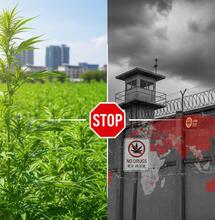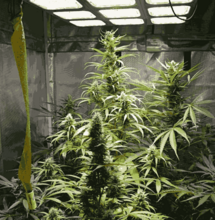A Beginner’s Guide to Training Cannabis Plants

If you are new to growing Cannabis, then you may be familiar with plant training and the benefits associated. Not only can training allow a grower to manipulate the canopy, resulting in larger yields, it can also help save space and encourage a grower to become more hands on with their indoor garden. In this article we explain all about plant training, the various methods and benefits associated.
What Is Plant Training?
In the same way we can train our bodies in the gym to become more athletic or stronger, the same applies to Cannabis plants. As the plants grow from seedlings into a vegetative small bush, certain techniques can be applied with recovery time granted, that can shape the final structure of a strain.
Not all Cannabis strains react the same to training techniques as others, so learning which plants prefer which techniques can be a learning curve. Short and stocky indica dominant cultivars will work better than tall, lanky and fast-growing sativa dominant plants with some training techniques, and vice versa.
When Should I Start Training My Plants?
The ideal window to perform the various different techniques is during the vegetative stage, meaning when the lights are on for 18/6. It is during this time your seedlings or clones will focus on producing a large mass of roots, branches, stems and waxy, lush foliage.
Once your plants have reached the 3rd internode, you may begin to apply techniques such as pinching out. However, you will want your plants to become tall enough and with enough branching, that you have a canopy to start with that can be easily tied down, super cropped, fimmed, pinched out or pruned. Usually when plants reach a height of 11 in (30 cm) and above, manipulating the final shape is much easier and will allow plants to respond quickest.
How Do I Train My Plants?
The beauty of training Cannabis plants is that depending on your end goal, you can customize which techniques are used, when they are performed and depending on your vegetative time can grow enormous plants prior to flowering under 12/12. All the plant training techniques covered below are very easy to perform, can be done by hand, or using a sharp and sterile pair of scissors or scalpel.
Technique: Pinching Out
Cannabis plants are an apical dominant species, meaning they will always produce a main crown shoot that will become the tallest point of the plant. When the growth hormone named auxin, which is responsible for vertical growth, is disrupted, the shape of the plants will become bushy and squat. Where there was once a single crown shoot, will now reveal the 2 smaller axillary shoots that grow together as a pair, causing the number of crown shoots to double each time.
The Benefit
- Pinching out can help reduce the final height and stretch when flowered.
- Sativa dominant strains can be controlled easier and encouraged to grow squat.
- Cannabis plants can be constantly topped, producing numerous growth sites.
- Indica strains will remain low when pinched out and become very stocky.
Technique: Super Cropping
A high stress technique that involves breaking the stem to purposely break the inner cell walls. This technique is hand performed using a twisting and snapping motion, and can sometimes occur naturally when a branch snaps over from heavy winds outdoors. It is best to perform super cropping on Cannabis plants that are older than 5 weeks and are able to take the trauma of the break and recover with a much stronger outer part that is pumped with growth repair hormone. Make sure you give plants 5-7 days to fully recover before attempting to super-crop other parts of the canopy.
The Benefit
- Super cropping causes plants to grow with a more compact and bushy structure.
- The original break becomes very tough and can support more weight.
- Snapping stems and allowing them to be set using string can also reduce height.
- Growth hormone is distributed to the rest of the plant, causing an increase in size.
Technique: LST
Low stress technique as the name suggests is a gentle way to trick Cannabis plants to fight over apical dominance and to become the crown shoot. As Cannabis plants naturally grow one tall central cola, by tying down the tallest shoots, the plants will encourage the remaining lower parts of the canopy to take their place and become the dominant crown shoots. After 3 days, the tied down parts will have grown back vertically and should align with the other growth sites, causing an even and square shaped canopy.
The Benefit
- A very gentle and easy to perform method which can increase yields significantly.
- LST can be continuously performed all the way until the start of the flowering period.
- Tying down can also help reduce the final height, especially during the stretching phase.
- There are many ways to tie plants down using string, nets, weights and wire.
Technique: Combine Plant Ties and Bamboo Cane
This is another method to support cannabis plants before they enter the flowering period. Using both plant ties and bamboo canes will help the plants focus their energy on top-heavy fat buds, and also prevent the side branches from toppling over and touching one another. When using plant ties, be careful not to cut through the plants, and make sure that the canes you are using are well inserted into the pots, and firmly support the side branches.
The Benefit:
- Plant ties combined with thin bamboo canes are an excellent way to ensure your plants have the ideal framework to flower around.
- The distribution of colas is more even around the canopy when you use plant ties and canes.
- Bamboo canes can be washed and reused again in your next cycle for growing.
Technique: Fimming
A version of topping, however, 30% of the top shoot is purposely left on. Rather than totally remove the top shoot and expose the two auxiliary shoots, by leaving part of the top part behind, the plants will focus their growth energy on the remaining side branches and new shoots. Again, it takes around 5–7 days for the plant's growth to resume back to normal, causing a busy and squat profile. To correctly perform fimming, a clean and sterile pair of scissors should be used.
The Benefit
- Fimming allows the lower parts of the canopy to become more established.
- Yields can be increased, with some strains reacting better than others.
- Only a pair of scissors is required to make a clean cut, removing 70% growth.
- Fimmed plants will produce more lower shoots, ideal for cloning.
Technique: Pruning
Pruning or lollipopping is an old school method that basically involves removing the foliage of a set part of the plants. The goal is to allow the plant’s energy to be diverted into the remaining canopy, producing only large sized buds, and disregarding any undeveloped popcorn sized lower buds. Pruning can be done slowly over time, or it can often be a heavy strip that can remove up to 80% of the foliage in one go. Use a sharp pair of scissor, or scalpel, or even razor blade to achieve a clinical finish as you carefully cut the leaves and side shoots that would usually produce smaller sized lower buds.
The Benefit
- Pruning plants will improve the air flow around the pots and grow room.
- Yields will be increased and there is no concern over small sized buds.
- An excellent way to take healthy viable clones before flowering under 12/12.
- The risk of powdery mildew and mold is reduced when plants have been pruned.
What About Badly Damaged or Broken Stems?
There will be times when things do not exactly go according to plan, and this can mean heavy hands, weak plants, or that you simply did not provide enough recovery time. The worst-case scenario that can happen is that the stem will break due to pressure, become lifeless and die. Super cropping can sometimes cause the break to heal with a knuckle; however, it can become moldy and infected. So, it’s important to perform training techniques as gently as possible and always use clean tools when you work with the plants in order to avoid causing unwanted and irreversible damage.

5 Extra Tips to Consider When Training Cannabis Plants
Top tip #1 - Always use a sterile, sharp scalpel
It cannot be emphasized enough how important it is to always use sharp and clean tools when taking cuttings or pruning. A blunt blade will not provide the clean cut required and may encourage tiny growth shoots to appear later on. Our top tip here is to sharpen your scissors or buy a pack of razor blades and keep them around for clones and pruning.
Top tip #2: Give plants time to fully recover
Recovery time is an essential part of plant training, and while there are low and high stress techniques, allowing plants to bounce back after working on them will be the difference between big, bushy and vigorous plants, compared to weak and stunted ones. Our top tip here is to give plants between 5–7 days depending on maturity, before applying any more stress to the canopy.
Top tip #3 - Improve airflow by pruning fan leaves
How much air flow is present in the grow room will have a direct effect on how plants transpire, use nutrients and are able to produce top quality buds. Removing the fan leaves below the top part of the canopy is a great way to ensure the air flow is free flowing and there are no stagnant air pockets. Our top tip here is to make sure there is plenty of fresh air currents blowing around the bottom, middle and top of the plants using oscillating fans kept low.
Top tip #4 - Takes clones when defoliating
It may be disheartening removing all the healthy foliage you have spent months growing, but taking clones from the pruned foliage will allow you to root large sized clones. This can also be a great time to vegetate those clones for the next flowering run, on the basis you have a separate room.
Top tip #5 - Add support early on
Most growers will only add bamboo canes or yo-yo gadgets once they notice the buds are becoming top-heavy with weight and may even droop towards the ground in some cases. Our top tip here is to take the time to add the support canes early on. This makes life easy and keeps the plants well organized.
The benefits of training Cannabis plants
- The shape and structure of a cannabis plant can be changed and manipulated.
- Yields can be significantly increased after training techniques have been applied.
- Training is easy to do and is not expensive, making it ideal for everyone to try.
- The final height of a stretching plant can be reduced when trained correctly.
- Plants will focus their energy on the top part of the canopy, not the little buds.
- Training and pruning can save time trimming once the plants are harvested.
- Growers with a small grow space and get the most out of a few plants.
Final words
Training Cannabis plants can be a learning curve that takes time and patience. Not all strains will react the same way, and as a beginner, working with indica dominant varieties can be the best starting point. It is essential that when applying the various techniques covered above, that you allow plenty of recovery time and give the plants time to fully heal. Always work with clean tools for pruning and cutting and bear in mind that timing is the most important thing, including the right age to perform low or high stress techniques on, recovery time and the last available point to train plants once flowering is under way. Good luck finding out which methods work best for you and taking your yields to the next level!
Also read on Soft Secrets:
- 8 Ways To Get The Biggest Yields Indoors














